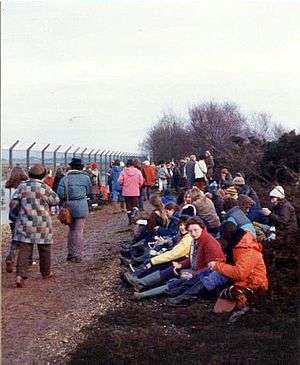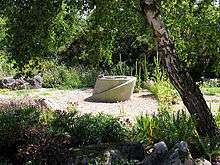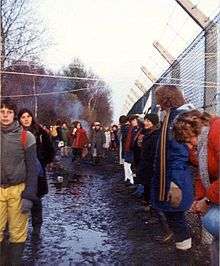Greenham Common Women's Peace Camp
| Greenham Common Women's Peace Camp | |
|---|---|
 Women gathering outside of the fence at Greenham Common in order to hold a demonstration against the cruise missiles. | |
| Date | September 1981–2000 |
| Location | RAF Greenham Common, Berkshire, England |
| Caused by | Storage of cruise missiles inside of RAF Greenham Common |
| Goals |
Removal of cruise missiles End of use of nuclear weapons World peace |
| Status | Ended (2000) |
Greenham Common Women's Peace Camp was a series of protest camps established to protest nuclear weapons being placed at RAF Greenham Common in Berkshire, England. The camp began in September 1981 after a Welsh group, Women for Life on Earth, arrived at Greenham to protest against the decision of the British government to allow cruise missiles to be stored there.[1] After realising that the march alone was not going to get them the attention that they needed to have the missiles removed, women began to stay at Greenham to continue their protest.[2] The first blockade of the base occurred in May 1982 with 250 women protesting, during which 34 arrests were made.[3] The camp was active for 19 years and disbanded in 2000.[4]
History
The first act of resistance by the Greenham Common Peace Camps came about when, in September 1981, 36 women chained themselves to the base fence in protest against nuclear weapons.[3] On 29 September 1982, the women were evicted by Newbury District Council but set up a new camp nearby within days.[5] In December 1982, 30,000 women responded to a chain letter sent out and joined hands around the base at the Embrace the Base event.[3]
The camps became well-known when on 1 April 1983, about 70,000 protesters formed a 14-mile (23 km) human chain from Greenham to Aldermaston and the ordnance factory at Burghfield.[6][7] The media attention surrounding the camp inspired people across Europe to create other peace camps.[1] Another encircling of the base occurred in December 1983, with 50,000 women attending. Sections of the fence were cut and there were hundreds of arrests.[3][8]
On 4 April 1984, the women were again evicted from the Common; again, by nightfall many had returned to reform the camp.[9] In January 1987, although Parliament had been told that there were no longer any women at Greenham, small groups of women cut down parts of the perimeter fence at Greenham Common every night for a week.[10]
The protestors consisted of nine smaller camps at various gates around the base. Camps were named after the colors of the rainbow, as a way of contrasting against the green shades of the base.[11] The first camp was called Yellow Gate, and others included Blue Gate with its New Age focus; Violet Gate with a religious focus; and Green Gate, which was women-only and did not accept male visitors.[3]

The last missiles left the base in 1991 as a result of the Intermediate-Range Nuclear Forces Treaty, but the camp remained in place until 2000, after protesters won the right to house a memorial on the site.[12] Although the missiles had been removed from the base, the camp was continued as part of the protest against the forthcoming UK Trident programme. Sarah Hipperson, who had been a part of the protest for all nineteen of its years, was among the last four women to leave the camp.[13]
The old camp was inaugurated as a Commemorative and Historic Site on 5 October 2002. There are seven standing stones encircling the 'Flame' sculpture representing a camp fire. Next to this there is a stone and steel spiral sculpture, engraved with the words "You can't kill the Spirit."[14] There is also a plaque there for activist Helen Wyn Thomas who was killed near the site.[15] The site has since been given to the Greenham Common Trust to care for.[14]
Protest strategies
The women at Greenham used actions, posters, and songs to protest against the nuclear missiles and gain attention.
The first protest action undertook at Greenham involved women chaining themselves to the fence of the base in September 1981. The most well-known protest actions that the Greenham women undertook were the Embrace the Base event and their human chain protests. At Embrace the Base, 30,000 women held hands around the perimeter fence. In April 1983, the Greenham women and their supporters created a 14-mile human chain. In December of that year, another human chain was created, circling around the fence, while some parts of the fence were cut.[3][8] In at least once instance, the women dressed as witches and attempted to cut down the base's fence.[16]
The Greenham women would often 'keen.' They would dress in black, and say that they were mourning for children that would be lost in the future due to nuclear war.[17]
Posters were used by the women at Greenham, and often featured the symbol of a spider web, meant to symbolise the fragility and perseverance of the Greenham women.[18]
Singing was another protest strategy utilised by the Greenham women. Popular songs were sometimes used, with their lyrics rewritten to support the anti-nuclear cause. Some of the songs were original, written by the women of the camps.[19] In 1988, "Greenham Women Are Everywhere", the official songbook of the camp, was published.[20]
Importance of gender

In February 1982 it was decided that the protest should involve women only.[21] This was important as the women were using their identity as mothers to legitimise the protest against nuclear weapons, all in the name of the safety of their children and future generations.[22]
The spider web became one of the most-used symbols at the camp, because it is both fragile and resilient, as the Greenham women envisioned themselves.[18] The Greenham women were notorious for dressing themselves up as witches,[16] in order to contrast the symbol of the evil witch with the actions of ordinary women at the base.
There were several instances when women entered the camp, thus entering "male" space. On New Year's Eve 1982, the women broke into the base for the first time; 44 women climbed over the military base's fence and climbed on top of the silos and danced around on them for hours. All the women were arrested, and 36 were imprisoned.[21] On 1 April 1983, 200 women entered the base dressed as teddy bears.[21] A "child" symbol like the teddy bear was a stark contrast to the highly militarised atmosphere of the base; the women again were highlighting the safety of their children and future generations of children.[22]
The next major event was 'Reflect the Base' on 11 December 1983, when 50,000 women circled the base to protest against the cruise missiles which had arrived three weeks earlier.[21] The day started as a silent vigil where women held up mirrors as to allow the base to symbolically look back at itself and its actions; however, the day ended with hundreds of arrests as the women pulled down large sections of the fence.[21]
Upon breaching the barriers and entering the base, the women were making the statement that they would not stay at home and do nothing, as women are traditionally expected to do while the men take care of the serious "male" issues.[22] Their refusal to go home at the end of each day was a challenge against the traditional notion that a woman's place was in the home. Many media outlets even questioned the behaviour of the Greenham women: if their children were so important to them, they asked, then why were they not home with them?[22] The media tended to ignore the Greenham women's collective identity of "women as mothers" protecting the children and largely focused on the illegitimacy of the camp, describing it as a witches' coven laden with criminal activity, with the women posing a threat to family values and the state.[22]
Related movements: Window Peace
The Greenham Common Women’s Peace Camp inspired related peace movements in the U.K. as well as abroad. One such movement was Window Peace, a year-long live-in performance art installation in New York City.[23] As a tribute to the protestors of the original movement, who at the time had been living outside of the Greenham RAF camp, as well as to the Seneca Women's Peace Encampment,[24] women artists and activists created a rotating series of art installations in an empty storefront along West Broadway in Manhattan.
The Window Peace installation, created in 1986 by artist Susan Kleckner, took place in the Soho Zat storefront, located in lower Manhattan.[25] As had been the practice of the Greenham Common movement, only women artists could participate; however, men were allowed to participate if they had been invited by a woman. Each week for an entire year, beginning 12 December 1986 until 11 November 1987, 51 women artists[24] occupied the storefront window with their art. Among the artists were Susan Kleckner (also the originator), Ann Snitow, Dianna Moonmade, Sharon Jaddis, Tequila Minsky, Anne Meiman, Carol Jacobsen, Joyce George, Jane Winter, Marsha Grant, The Women of the Greenham and Seneca Movements, Catherine Allport, Eileen Jones, Susann Ingle, Sharon Smith, Linda Montano, Dominque Mazur, Cenen, Pamela Schumaker, Judy Trupin, Connie Samaras, E.A. Racette, Peggey Lowenberg and Maggie Ens, Kathy Constantinides, Elaine Pratt, Coco Gordon, Sally Jacque, Kay Roberts, Anna Rubin, Renee Rockoff, Harriet Glazier, Karen Marshall, Paula Allen, and others.[26]
See also
References
Footnotes
- 1 2 Cortright 2008.
- ↑ Liddington 1989, p. 230.
- 1 2 3 4 5 6 "Records of Greenham Common Women's Peace Camp (Yellow Gate)". National Archives.
- ↑ Hipperson, Sarah. "Greenham Common Women's Peace Camp". Greenham Common Women's Peace Camp.
- ↑ Red Rag 1982.
- ↑ "1983: Human chain links nuclear sites". British Broadcasting Corporation. 1 April 1983. Retrieved 5 January 2010.
- ↑ Brown, Perera & Wainwright 1983.
- 1 2 Kissed 1984.
- ↑ "1984: Greenham Common women evicted". British Broadcasting Corporation. 4 April 1984. Retrieved 5 January 2010.
- ↑ Red Rag 1987.
- ↑ Fairhall 2006, p. 44.
- ↑ The Guardian 2000.
- ↑ Mair, Eddie (3 November 2011). PM (Radio broadcast).
- 1 2 BBC News 2014.
- ↑ Hipperson, Sarah. "Greenham Common Women's Peace Camp Commemorative & Historic Site". Greenham Common Women's Peace Camp.
- 1 2 Fairhall 2006, p. 58.
- ↑ Burton (1984). Harford, Barbara; Hopkins, Sarah, eds. Greenham Common: Women at the Wire. London: Women's Press. p. 15. ISBN 0704339269. OCLC 12669725.
- 1 2 Fairhall 2006, pp. 40-41.
- ↑ Fairhall 2006, p. 24.
- ↑ "Greenham Women Are Everywhere - Songs" (PDF). aldermaston.net.
- 1 2 3 4 5 "Your Greenham Chronology". The Guardian. Retrieved 22 September 2013.
- 1 2 3 4 5 Shepherd 2010.
- ↑ ""Window Peace" December 12, 9186-November 11, 1987 at Soho Zat, 307 Broadway, NY". The New Common Good. 1987. Folder: "Pacifism/Peace Movement/"Window Peace" Installation ca. 1987. Retrieved 6 March 2016.
- 1 2 Kleckner 1987.
- ↑ Patterson 2012.
- ↑ Constantinides, Kathy (1987). "Letter about Window Peace". Brooklyn, NY. Folder: "Pacifism/Peace Movement/"Window Peace" Installation ca. 1987. Retrieved 6 March 2016.
Bibliography
- Brown, Paul; Perera, Shyama; Wainwright, Martin (2 April 1983). "Protest by CND stretches 14 miles". The Guardian. Retrieved 16 May 2015.
- Cortright, David (2008). Peace: A History of Movements and Ideas. Cambridge University Press.
- Fairhall, David (2006). Common Ground: The Story of Greenham. I.B. Tauris.
- Harford, Barbara; Hopkins, Sarah, eds. (1984). Greenham Common: Women at the Wire. London: Women's Press. ISBN 0704339269.
- "Greenham Peace Camps Evicted". Red Rag. 17 October 1982.
- "Greenham Common Peace Garden handed to trust". BBC News. 10 November 2014.
- Hipperson, Sarah. "Greenham Common Women's Peace Camp". Greenham Common Women's Peace Camp.
- Hipperson, Sarah. "Greenham Common Women's Peace Camp Commemorative & Historic Site". Greenham Common Women's Peace Camp.
- Kissed, Anna (8 January 1984). "Moles & Lemmings". Red Rag.
- Liddington, Jill (1989). The Long Road to Greenham: Feminism and Anti-Militarism in Britain Since 1820. Virago Press.
- Kleckner, Susan (30 April 1987). "For Immediate Release: Window Peace" (Press release).
- Mair, Eddie (3 November 2011). PM (Radio broadcast).
- "More Actions at Greenham!!". Red Rag. 11 February 1987.
- Patterson, Clayton (4 July 2012). "From ComFest and Columbus to Soho Zat and back again". The Villager.
- Records of Greenham Common Women's Peace Camp (Yellow Gate). London University: London School of Economics, The Women's Library.
- Shepherd, Laura J. (2010). Gender Matters in Global Politics. New York: Routledge.
- "Your Greenham Chronology". The Guardian. Retrieved 22 September 2013.
- "19-year Greenham Common campaign to end". The Guardian. 5 September 2000.
- "1983: Human chain links nuclear sites". BBC On This Day. Retrieved 5 January 2010.
- "1984: Greenham Common women evicted". BBC On This Day. Retrieved 5 January 2010.
Further reading
Primary sources
- Greenham Women Are Everywhere, the official songbook of the Greenham Common Women's Peace Camp
Several sets of papers related to Greenham Common Women's Peace Camp are held at The Women's Library at the Library of the London School of Economics, including;
Secondary sources/anthologies
- Cook, Alice; Kirk, Gwyn, eds. (1983). Greenham Women Everywhere: Dreams, Ideas, and Actions from the Women's Peace Movement. Pluto Press.
- Fairhall, David (2006). Common Ground: The Story of Greenham. I.B. Tauris.
- Harford, Barbara; Hopkins, Sarah, eds. (1984). Greenham Common: Women at the Wire. The Women's Press.
- Laware, Margaret L. (2004). "Circling the Missiles and Staining Them Red: Feminist Rhetorical Invention and Strategies of Resistance at the Women's Peace Camp at Greenham Common". NWSA Journal. 16.3: 18–41. JSTOR 4317078.
- Liddington, Jill (1989). The Long Road to Greenham: Feminism and Anti-Militarism in Britain Since 1820. Virago Press.
- Lowry, Maggie (1983). "A Voice from the Peace Camps: Greenham Common and Upper Heyford". In Thompson, Dorothy. Over Our Dead Bodies: Women Against the Bomb. Virago Press. pp. 73–77.
- Roseneil, Sasha (1995). Disarming Patriarchy: Feminism and Political Action at Greenham. Open University Press.
- Seller, Anne (1985). "Greenham: A Concrete Reality". Frontiers: A Journal of Women Studies. 8.2: 26–31. JSTOR 3346050.
External links
- Documentary from undercurrents about the march that started Greenham Common Women's Peace Camp
- Greenham Common Women's Peace Camp website
- Greenham Common Camp Festival website
- YourGreenham.co.uk, information about Greenham from The Guardian
- Article on Greenham Common Women’s Peace Camp by the International Museum of Women.
- How the Greenham Common protest changed lives: ‘We danced on top of the nuclear silos’. The Guardian. Authors - Suzanne Moore, Homa Khaleeli, Moya Sarner, Leah Harper and Justin McCurry. Published 20 March 2017.
- Remembering Greenham Common. New Statesman. Author - Kate Hudson. Published 18 April 2013.
Coordinates: 51°22′18.07″N 1°16′40.79″W / 51.3716861°N 1.2779972°W